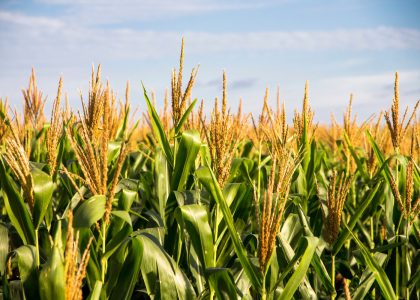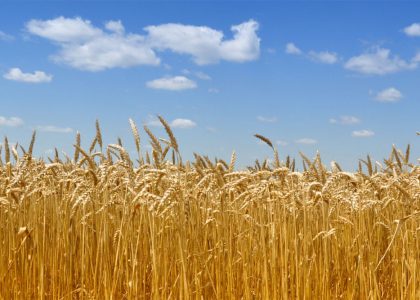Weekly Outlook: What Corn and Soybean Yield is the Market Trading?
Good, D. "Weekly Outlook: What Corn and Soybean Yield is the Market Trading?" farmdoc daily (6):149, Department of Agricultural and Consumer Economics, University of Illinois at Urbana-Champaign, August 8, 2016.
Ample July precipitation in a large portion of the U.S. corn and soybean production areas, coupled with very high crop condition ratings for both crops, have generated expectations for large yields for both crops. Those expectations have resulted in a sharp decline in prices beginning in mid-June for corn and early July for soybeans.
The USDA is scheduled to release the first survey-based yield and production forecasts of the season on August 12. As the release date approaches, yield estimates by private analysts are becoming available, more for corn than for soybeans so far. The USDA calculates the trend corn yield for 2016 at 168 bushels per acre and corn yield expectations are generally high. However, there is a surprisingly large range in the estimates. Expectations are clustered between 167 and 172 bushels, but appear to range between about 160 and 175 bushels per acre. A number of factors likely contribute to the large range in expectations.
Yield expectations at the low end of the range may reflect relatively dry conditions in some important production areas over the past two weeks, and for longer periods in some areas (see the National Weather Service Precipitation maps). In addition those expectations may reflect ideas that periods of above normal temperatures during June and early July may have resulted in some pollination issues and that upcoming periods of above normal temperatures may adversely affect grain fill. In sum, yield expectations at the low end of the range reflect the possibility of some crop issues that are masked by the weekly crop condition ratings. For example, the incidence of ear "tip back" (corn kernels not extending to the end of the cob) has received a lot of discussion this year in terms of potential impact on yields. Quantifying the incidence and impact of such conditions on U.S. yield potential is extremely difficult, as discussed in a recent article by Emerson Nafziger in the Department of Crop Sciences at the University of Illinois. Yield expectations at the high end of the range likely reflect the incidence of above normal rainfall in many areas during July, lack of extended periods of above normal temperatures, and generally healthy plant conditions as reflected in the weekly crop condition ratings.
So what yield is the market actually trading? It is difficult to extract a yield expectation from current futures prices for the 2016-17 marketing year since the market trades both supply and demand expectations. USDA marketing year, supply, demand, and price projections can be used as a starting point. As indicated, the USDA calculates the trend yield for 2016 at 168 bushels per acre, which would produce a crop of 14.54 billion bushels. As projected in the July 12 WASDE report, a crop of that size points to 2016-17 marketing year ending stocks of 2.081 billion bushels and a marketing year average farm price centered on $3.40 per bushel. The USDA's Economic Research Service (ERS) has developed a model that projects the marketing year average farm price of corn based on current futures prices, 5-year average U.S. seasonal basis values, and 5-year average monthly farmer marketing weights. Using the closing futures prices of August 5, that model projects the season average price at $3.21 per bushel. Assuming that market expectations for corn demand and consumption during the year ahead are similar to those projected by the USDA, that price projection suggests that the market is likely trading a corn yield above 168 bushels and near the high end of expectations.
The USDA calculates the soybean trend yield for 2016 at 46.7 bushels per acre. Current private sector reports of expected 2016 soybean yields are less numerous than for corn, but appear to be clustered in the 47 to 48 bushel range. Above-trend yield expectations generally reflect very high crop condition ratings. Like corn, however, there are some late season uncertainties about the soybean crop. More numerous incidences of disease (sudden death syndrome, brown stem rot, and white mold) seem to be popping up. There is also some concern that the lush vegetative growth that has resulted in high crop condition ratings may be at the expense of yield potential (Nafziger, July 27, 2016). The importance of August weather also contributes to yield uncertainty.
Based on the projection of harvested acreage near 83 million, a trend yield of 46.7 bushels would produce a crop of 3.88 billion bushels. Based on a crop of that size, the July 12 WASDE report projected 2016-17 marketing year ending stocks of soybeans at 290 million bushels and a marketing year average farm price centered on $9.50 per bushel. Using the ERS model that forecasts the marketing year average farm price of soybeans based on futures prices, closing futures prices on August 5 pointed to a marketing year average farm price of $9.28. Again, assuming the market expectation of soybean demand and consumption during the year ahead is similar to that of the USDA, the market appears to be trading an average yield above trend value and near the expected levels being reported in the trade.
While both corn and soybeans are receiving some modest support from late season demand strength in the export market, prices remain pressured by expectations for above trend yields and record crops in the U.S. Yield expectations reflected by current corn prices are especially high.
References
National Weather Service, Precipitation Forecast Maps (accessed August 8, 2016). http://water.weather.gov/precip/
Nafzinger, E. "'Tip-back' and the 2016 corn crop." Integrated Pest Management Bulletin, Department of Crop Sciences, University of Illinois at Urbana-Champaign, August 4, 2016. http://bulletin.ipm.illinois.edu/?p=3705
USDA Economic Research Service, Season-Average Price Forecasts (accessed August 8, 2016).
http://www.ers.usda.gov/data-products/season-average-price-forecasts.aspx
Nafzinger, E. "'Soybean: crunch time to come." Integrated Pest Management Bulletin, Department of Crop Sciences, University of Illinois at Urbana-Champaign, July 27, 2016. http://bulletin.ipm.illinois.edu/?p=3698





